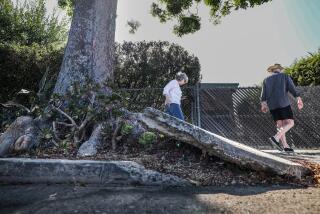L.A. business improvement districts’ value questioned
When the bike patrols suddenly ended in downtown Los Angeles’ arts district last month, junk began to pile up against the curb on Seaton Street.
Over on Mateo Street, a trail of aqua-blue chips from shattered car windows glittered along the gutter.
“It’s like they got the memo the guys were gone,” said actress Dawn Cody, who lives in the arts district.
The private patrols were run by the neighborhood’s business improvement district — one of 10 downtown and 39 throughout Los Angeles. The city authorizes them to collect fees from property owners to fund services that City Hall can’t or won’t provide.
Many say the improvement districts have transformed downtown by enlisting cleanup and security crews and promoting the once-abandoned area to new residents and investors.
But critics say that in the newly thriving central city, some business improvement districts have become bloated bureaucracies whose job can be done cheaper and better by others.
“There is no need to spend $1.3 million per year to keep the neighborhood clean,” Yuval Bar-Zemer, who developed the arts district’s Biscuit Company Lofts, said in an email. “We could get it done in a fraction of the cost, and we may be able to get the city to contribute the baseline services that we all deserve.”
After Bar-Zemer and other property owners took the city to court, a Los Angeles Superior Court judge ruled in December that the improvement district had overstepped its authority by sponsoring bus tours and other marketing efforts aimed at outsiders.
Improvement districts are supposed to be voluntary pacts that serve property owners. They’re not supposed to morph into mini-governments serving the community at large.
The arts district group was ordered to disband in May. Overnight, the men and women in the bright blue shirts who scrubbed graffiti, washed sidewalks and deflected petty crime vanished.
The court ruling comes as improvement districts in California are facing increasing legal challenges. An appeals court in 2011 ordered the city of San Diego to disband a district in Golden Hill, a historic working-class neighborhood near downtown. Two more legal challenges to similar districts were filed last year, also in San Diego.
Los Angeles paid $580,000 last year to settle a suit by the owners of Angelus Plaza, a nonprofit senior complex on Bunker Hill, over improvement district fees. The complex’s owners have a similar claim pending over a senior housing project in San Pedro.
Some leaders fear the arts district ruling could be a setback for downtown’s ongoing reincarnation as a signature entertainment and residential area.
The Downtown Center Business Improvement District devotes 27% of its $5.4-million budget to economic development, communications and marketing, said Carol Schatz, who heads the group. The tours and websites that improvement districts sponsor were instrumental in bringing bars, restaurants and boutiques back into downtown, Schatz said.
“Even Staples, unbelievably, wasn’t a slam-dunk,” she said. “We helped to facilitate innumerable deals.”
The arts district lies between the Los Angeles River and Alameda Street, on the eastern edge of downtown.
The punk artists who took over its old brick warehouses decades ago were in the first wave of the reoccupation of the central city, and the anarchist impulse lives on. Some residents disdain the improvement district officers for hustling transients along too roughly, saying a little bit of grit hones the creative edge.
The dispute reflects growing pains that have emerged since luxury lofts and high-end restaurants popped up amid cold storage businesses and a jeans manufacturer.
The property owners who brought the suit said they were added to the improvement district against their will in 2011. They also said the improvement district’s role in turning the area around was exaggerated.
“It is the development and revitalization of old buildings that improves the area,” Bar-Zemer wrote, “not a privately managed group of kids on bikes.”
But Estela Lopez, head of the Central City East Assn., said that her group was instrumental in the arts district taking off and that without it, the neighborhood will decline.
“It’s already fraying around the edges,” said Lopez, whose group ran the arts area improvement district and continues to operate one in downtown’s industrial core.
Improvement district charters typically must be renewed every five years. The voting often is weighted by square footage and street frontage, so a few large property owners can kill a district.
That’s what happened in 2009, when downtown toy district property owners defeated a renewal attempt.
Lopez said lawyers are recommending against appealing the arts improvement district dissolution order.
“There is no playbook for this,” she said.
The online reaction to the improvement district pullout has been predictably nasty, with some arts district residents sketching nightmare scenarios of crime, homeless encampments and discarded needles washing in from skid row, less than a mile away.
Others say the improvement district made no difference. Major violent and property crime rates in the neighborhood are holding steady, according to Los Angeles Police Department statistics.
A rough consensus seems to be growing that some services need to resume. A community group could contract out for them or a new improvement district could be formed by Central City East or some other group, without the public relations functions. Setting up a new improvement district could take more than a year, however.
Some residents say they’ll take care of the neighborhood themselves until something else comes along. On a balmy evening recently, a dozen people set out on a neighborhood watch walk.
Reginald Benson, a security officer at the Southern California Institute of Architecture, said he missed the bike patrols from the business improvement district, also known as a BID.
“There was a homeless person who was a little bit belligerent today,” Benson said. Improvement district patrols “would show up in numbers. Sometimes that does the trick.”
Several neighbors pointed out trash, but it was no worse than in other parts of downtown.
A bike contingent joined up, and a gallery owner stopped the group to explain a storefront video installation. At the Pie Hole, people chatted over slices of Mexican chocolate pastry, and the porch at Wurstkuche was full of beer drinkers noshing on sausages.
“This is how we roll,” said Melissa Richardson Banks, who runs a downtown website. “Same BID, new BID, no BID, we’re a community.”
Times staff writer Ben Welsh contributed to this report.
More to Read
Sign up for Essential California
The most important California stories and recommendations in your inbox every morning.
You may occasionally receive promotional content from the Los Angeles Times.










